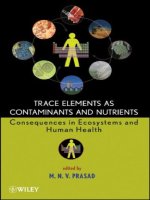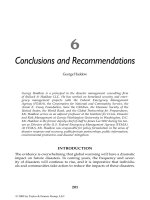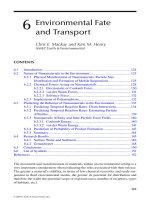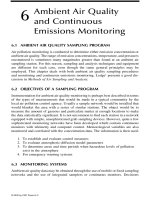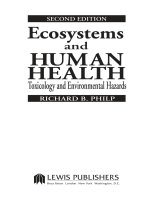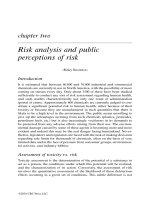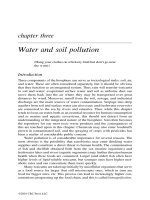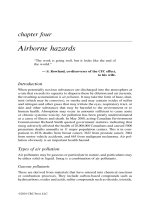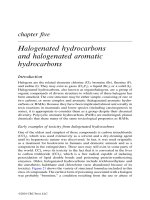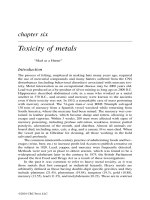Ecosystems and Human Health - Chapter 6 pps
Bạn đang xem bản rút gọn của tài liệu. Xem và tải ngay bản đầy đủ của tài liệu tại đây (72.28 KB, 19 trang )
©2001 CRC Press LLC
chapter six
Toxicity of metals
“Mad as a Hatter”
Introduction
The process of felting, employed in making hats many years ago, required
the use of mercurial compounds and many hatters suffered from the CNS
disturbances (including behavioral disorders) associated with mercury tox-
icity. Metal intoxication as an occupational disease may be 4000 years old.
Lead was produced as a by-product of silver mining as long ago as 2000 B.C.
Hippocrates described abdominal colic in a man who worked as a metal
smelter in 370 B.C., and arsenic and mercury were known to the ancients
even if their toxicity was not. In 1810, a remarkable case of mass poisoning
with mercury occurred. The 74-gun man-o’-war HMS Triumph salvaged
130 tons of mercury from a Spanish vessel wrecked while returning from
South America, where the mercury had been mined. The mercury was con-
tained in leather pouches, which became damp and rotten, allowing it to
escape and vaporize. Within 3 weeks, 200 men were affected with signs of
mercury poisoning, including profuse salivation, weakness, tremor, partial
paralysis, ulcerations of the mouth, and diarrhea. Almost all animals on-
board died, including mice, cats, a dog, and a canary. Five men died. When
the vessel put in at Gibraltar for cleaning, all those working in the hold
salivated profusely.
The common nineteenth-century practice of adulterating foods and bev-
erages (wine, beer, etc.) to increase profit led Accum to publish a treatise on
the subject in 1820. Lead, copper, and mercury were frequently detected.
Methods were not yet in place to detect arsenic, which was found to be a
widespread adulterant later in the century. In 1875, the British Parliament
passed the first Food and Drugs Act as a result of these investigations.
In the past it was common to refer to heavy metal toxicity, as it was
those metals that first emerged as industrial hazards. Heavy metals are
arbitrarily defined as those having double-digit specific gravities and they
include platinum (21.45), plutonium (19.84), tungsten (19.3), gold (18.88),
mercury (13.55), lead (11.35), and molybdenum (10.22). These are in contrast
©2001 CRC Press LLC
to iron (7.87), manganese (7.21), chromium (7.18), zinc (7.13), selenium (4.78),
and aluminum (2.70). Intermediate are copper (8.96) and cadmium (8.65).
In general, it can be seen that metals with specific gravities less than 8
are mostly essential trace nutritional elements (copper also is one and there-
fore the exception, as is aluminum, which is not a nutritional element),
whereas those having specific gravities greater than 8 are the more toxic
ones. It must be stressed once again that dose is all-important. Aluminum,
with a specific gravity of 2.70, has toxic properties. Arsenic exists in two
solid forms: yellow arsenic (1.97) and grey or metallic arsenic (5.73). Both
are highly toxic.
Lead (Pb)
The Latin word for lead is
plumbum
, hence the chemical designation Pb. This
word also gave origin to such English ones as plumb bob (a mason’s line
with a metal ball attached for establishing vertical trueness), plummet (to
fall as if leaden), and aplomb (to be as calm and undeviating as a plumb
line). Lead was obviously well known to the ancients. In fact, they spent a
lot of time trying to turn it into gold (alchemy). Lead toxicity was also
familiar to them. Diascorides described its CNS toxicity as delirium.
Despite early knowledge of lead’s toxic effects, the low melting point of
the metal, coupled with its density, made it popular and useful. Well into
the 1940s and early 1950s, it was possible to buy lead toys, and kits were
available to cast lead soldiers and lead fishing weights. An 1885 description
of chronic lead poisoning is as good as any to be found in a modern text:
The chief signs of chronic poisoning are those of general
ill health; the digestion is disturbed, the appetite lessened,
the bowels obstinately confined, the skin assumes a pecu-
liar yellowish hue, and sometimes the sufferer is jaun-
diced. The gums show a black line from two to three lines
in breadth, which microscopical examination and chemical
tests alike show to be composed of sulfide of lead; occa-
sionally the teeth turn black. The pulse is slow and all
secretions are diminished. Pregnant women have a ten-
dency to abort. There are also special symptoms, one of
the most prominent of which is lead colic. This colic is
paroxysmal and excruciating.
Modern-day sources of lead are numerous. In the eighteenth century,
the industrial West discovered what the Chinese had known for centuries,
namely that lead glazes produce crockery with a richer, smoother look. From
this source and from lead solder in cans and kettles and water pipes leached
by soft (but not hard) water, we consume about 150
µ
g/day. In some areas,
the figure may reach 1 to 2 mg. Children are more vulnerable because all
dirt and dust contain lead, especially in cities where lead from auto exhaust
©2001 CRC Press LLC
(tetraethyl lead) settles out on the ground. This will persist long after the
conversion to lead-free auto fuel. Children may also consume old lead-based
paint, common in older buildings and which may also be on cheap wooden
toys. In children, CNS toxicity is the dominant feature. This starts with
vertigo and irritability, progressing to delirium, vomiting, and convulsions.
The mortality rate is about 25% if treated and about 65% if untreated. In
infants, exposure produces progressive mental deterioration after 18 months,
with loss of motor skills, retarded speech development, and hyperkinesis in
some cases. In the United States, the Lead Paint Poison Prevention Program
was introduced in 1970. Since that time, the mean blood lead level of U.S.
children has fallen from over 1
µ
mol/L (20.7
µ
g/dL) to less than 0.25
µ
mol/L
(5.2
µ
g/dL). Only two deaths in children from acute lead encephalopathy
have been reported in the past 20 years.
Children are not the only victims of lead poisoning from lead paint.
Sandblasting of old, lead-painted buildings may, over time, cause chronic
lead poisoning in workers who inhale the dust. Proper respirators and pro-
tective clothing are required for sandblasters. Heating of lead paint to a
sufficiently high temperature can release lead fumes that can be inhaled.
Cutting torches can produce sufficient heat to do this.
In all exposed individuals, subchronic toxicity can involve interference
with mitochondrial heme synthesis at several levels, with resultant hypo-
chromic (pale) microcytic (small) anemia. The pathway involved in this is
illustrated in Figure 25.
Toxicokinetics of lead
Elemental lead is not absorbed by the skin or through the alveoli of the lungs.
Inhaled particulate lead is returned to the pharynx by the bronchial cilia and
swallowed. Tetraethyl lead, however, may be absorbed across the skin and
alveoli and readily penetrates CNS. Most of it is destroyed in exhaust emis-
sions but sniffing leaded gasoline can result in severe CNS damage.
Gastrointestinal absorption of lead probably occurs via calcium channels
as lead is a divalent cation (Pb
2+
). It first appears in red blood cells, then
hepatocytes, and then the epithelial cells of the renal tubules. It is gradually
redistributed to hair, teeth, and bones where 95% of it is stored harmlessly.
The t
1/2
in blood is about 30 days; in bone, 25 years. Little reaches the adult
brain but much more enters the infant brain. Renal excretion is the main
route of elimination.
Cellular toxicity of lead
Lead affects oxidative phosphorylation and ATP synthesis in the mitochon-
drion. It also increases red cell fragility and inhibits sodium/potassium
ATPase. Kidney tubular cells become necrotic and chronic exposure may
lead to interstitial nephritis. Nuclear inclusion bodies, consisting of lead
bound to a protein, may be formed in renal cells. This may be considered
©2001 CRC Press LLC
as a protective mechanism. Carcinogenesis has been demonstrated in exper-
imental animals and chromosomal abnormalities have been observed, but
evidence of tumor production in humans is scarce. Most of the toxic effects
of lead and other heavy metals can be explained by their affinity for thiol
groups. This is also the basis of chelation therapy.
Fetal toxicity
A characteristic of all metals is their ability to penetrate the placental barrier,
so that fetal toxicity can occur as a result of maternal exposure. Lead (Pb) is
considered to be a human carcinogen and pregnant women are generally
removed from jobs where exposure may occur.
Prolonged exposure to low levels of Pb leads to impairment of the
learning process. Current experimental evidence suggests that Pb is inhibi-
tory to the NMDA receptor complex. Reduced availability of dopamine also
could be involved and hypocholinergic function has been described.
Figure 25
A simplified scheme showing points of interference of lead in heme syn-
thesis. See also Figure 22 for ALA synthase and heme inhibition.
SUCCINYL CoA + GLYCINE GAMMA AMINOLEVULINIC ACID
COPROPORPHYRINOGEN UROPORPHYRINOGEN PORPHYROBILINOGEN
ALA-DEHYDRATASE
COPROPORPHYRINOGEN
-OXIDASE
FERROCHELATASE
PROTOPORPHYRIN IX
CYTOCHROME-C
mitochondrion
mitochondrion
mitochondrial wall
cytosol
HEME
HEME OXIDASE
BILIRUBIN+Fe
ALA SYNTHASE
∗Pb
∗Pb
Pb∗
Pb∗
∗Pb
+ 4 Fe
+ Fe
©2001 CRC Press LLC
Treatment
Pb chelators are the treatment of choice. These bind Pb (and other divalent
cations) so that it can be excreted. Calcium/sodium ethylenediaminetetraac-
etate (CaNa
2
EDTA) and dimercaprol (British antilewisite, BAL) are given
intramuscularly followed by oral penicillamine for several weeks. BAL was
developed during World War II as a treatment for lewisite, a vesicant arseni-
cal poison gas. A newer chelator is
meso
-2,3,-dimercaptosuccinic acid
(DMSA). The chemical structures of these chelators are shown in Figure 26.
In the case of EDTA, Pb is exchanged for Ca
2+
, whereas with the others, the
Pb is bound to sulfhydryl groups. The complexes are excreted, primarily in
urine. A disadvantage of chelation therapy is that it does not remove Pb
from the brain very efficiently.
Despite 50 years of use, objective evidence for the benefit of chelation
therapy for Pb poisoning is scanty. It is widely agreed that it has drastically
reduced the mortality from Pb encephalopathy if diagnosis and treatment
are started early. It also relieves Pb colic, malaise, basophilic stippling, and
it rapidly restores red-cell ALA dehydratase. It does not influence the resid-
ual manifestations of chronic Pb poisoning such as peripheral neuropathy.
Mercury (Hg)
Mercury (Hg) exists in three forms: elemental mercury, inorganic compounds,
and organic compounds. Elemental mercury causes toxicity when the mer-
cury vapor is inhaled, as exemplified by the episode described at the begin-
ning of this chapter. The major source of elemental mercury in the environ-
ment is the natural degassing of the Earth’s crust. Estimates of the level of
mercury reaching the atmosphere range from 25,000 to 150,000 tons/yr, and
Figure 26
Chemical structures of some metal chelators.
DIMERCAPROL DMSA
D-PENICILLAMINE
HOOC COOHCH
SS
H
H
3
C
CH
3
H
2
CH COOHC
H
HH
S
H
SN
S
CH
CH
2
CH
2
CH
2
CCO
-
O
-
ONa
++
Na
O
OC
N
Ca
N
C
O
OO
CH
2
CH
2
CH
2
CH
2
CH
2
CH OH
Na
2
/Ca EDTA
meso
-DMSA
©2001 CRC Press LLC
the atmosphere represents a major mechanism for global transport of metallic
mercury. Conversely, anthropogenic sources account for only 10,000 tons/yr;
but because industrial effluent tends to be concentrated, these are the sources
usually associated with toxicity. Metallic mercury and its vapor can be an
industrial hazard. Mercury is used in the manufacture of chlorine and sodium
hydroxide by the mercury cell process, in paint preservatives, and in the
electronics industry. It is a by-product of smelting processes (most mineral
ores contain mercury), and it is released during fossil fuel combustion.
Elemental mercury toxicity
In vapor form, elemental mercury is well absorbed across both the alveoli
of the lungs and the blood-brain barrier. Acute poisoning usually occurs
within several hours. Weakness, chills, metallic taste, salivation, nausea,
vomiting, diarrhea, labored breathing, cough, and tightness in the chest may
ensue. If the exposure is more prolonged, interstitial pneumonitis may
develop. Recovery is usually complete except that residual loss of pulmonary
function may persist. Chronic exposure to mercury vapor results in CNS
disturbances, including tremor and a variety of behavioral changes that can
include depression, irritability, shyness, instability, confusion, and forgetful-
ness. Mercury vapor from mercury nitrate formerly used in the felting pro-
cess accounted for the “mad hatter” syndrome. The behavioral abnormalities
of the “Mad Hatter” in Lewis Carroll’s
The Adventures of Alice in Wonderland
were really quite mild, compared with the other characters, which is in
keeping with the topsy-turvy world that Carroll created. Thyroid distur-
bances may also be present.
Inorganic mercurial salts
Inorganic salts such as mercuric chloride can cause severe, acute toxicity.
The proteins of mucous membranes are precipitated, giving them an ash-
gray color in the mouth and pharynx. Intense abdominal pain and vomiting
are common. Loss of blood and fluid from the gastrointestinal tract results
from sloughing of the mucosa in the stool and may lead to hypovolemia and
shock. Renal tubular necrosis occurs after acute exposure and glomerular
damage is more common after chronic exposure. A phenomenon called
“pink disease” or acrodynia commonly follows chronic exposure to mercury
ions. It is a flushing of the skin that is believed to have an allergic basis.
Organic mercurials
Methylmercury is the most common cause of organic mercurial poisoning
and the most important one environmentally. It is extremely well absorbed
from the gastrointestinal tract (90%) and deposited in the brain. Because of
its high affinity for SH groups, methylmercury binds to cysteine and this
may then substitute for methionine and be incorporated into proteins. This
©2001 CRC Press LLC
can result in the formation of abnormal microtubles required for cell division
and neuronal migration. The main signs and symptoms are neurological and
consist of visual disturbances, weakness, incoordination, loss of sensation,
loss of hearing, joint pain, mental deterioration, tremor, and in severe cases,
paralysis and death. Infants exposed
in utero
may be deformed and retarded.
Experimentally, methylmercury has been shown in cell cultures to mobilize
Ca
2+
from intracellular stores that are sensitive to inositol 1,4,5-trisphosphate.
Mercury is a waste product of many industrial processes. It is methylated
in sediment by bacteria and cyanocobalamin. Several outbreaks of methyl-
mercury poisoning have occurred. The most widely known began in 1953
in Minimata, Japan, near a plant that manufactured acetaldehyde and dis-
charged mercury-containing compounds into Minimata Bay. People who ate
mollusks and large fish from the bay developed the symptoms that came to
be known as Minimata disease; 900 cases developed and there were 90
fatalities. Because of the high fetal toxicity of mercury, many deformed
infants were born. Another source of mercury toxicity is the consumption
of seed grains treated with methylmercuric chloride as a fungicide. Several
mass poisonings have occurred around the world. In Iraq in 1972, one such
episode resulted in over 6500 cases of poisoning and 500 deaths.
Mechanism of mercury toxicity
Mercury toxicity can be explained entirely by its ability to bind with the
hydrogen of sulfhydryl (SH) groups to form mercaptides (i.e., X-Hg-SR and
HgSR
2
, where X = an electronegative radical and R = a protein). Organic
mercurials such as methylmercury form mercaptides, R-Hg-SR’. The term
mercapto
means “to capture mercury” and refers to sulfur-containing groups.
Because SH groups are important components of many enzymes, mercury
acts as an enzyme poison and interferes with cell function at many levels.
Mercury can also combine with other physiologically important ligands such
as phosphoryl, carboxyl, amide, and amine groups. Metallic Hg vapor may
be oxidized by catalase enzyme in red blood cells to the less toxic divalent
form. Alcohol competitively inhibits this process. Mercury was an important
pharmaceutical agent for centuries, and its pharmacological properties also
depend on its affinity for SH groups. It was used as an antibacterial agent
(for syphilis), as a laxative, in skin creams, and in diuretics. Mercurial diuret-
ics were still in use in the 1960s. They were eventually replaced by safer
agents. Aminomercuric chloride may still appear in freckle-removing
creams, and daily application for years may result in increases in 24-hr urine
mercury excretions from 10
µ
g to 1 mg and the development of symptoms
such as excessive salivation and insomnia.
Treatment of mercury poisoning
Chelation therapy is recommended for elemental, inorganic mercury poi-
soning. Dimercaprol and penicillamine are SH-containing chelators. Dimer-
caprol is given intramuscularly and penicillamine, orally. Hemodialysis can
©2001 CRC Press LLC
also be used, and vomiting may be induced if there has been recent ingestion
of mercury. These treatments are of little use in methylmercury poisoning,
however. Dimercaprol actually increases brain levels of methylmercury, and
penicillamine and hemodialysis do not relieve symptoms. Some success has
been achieved with binding resins taken orally. Because there is a significant
enterohepatic recirculation of methylmercury (i.e., it is excreted in the bile
and reabsorbed from the intestinal tract), binding it to a polythiol resin
prevents its reabsorption because it is excreted in the feces.
The Grassy Narrows story
In 1969, Norvald Fimreite, a Ph.D. candidate in the Department of Zoology
at the University of Western Ontario, first made public his findings on the
mercury contamination of fish in Canadian and border lakes. The highest
levels were recorded from a small lake, Pinchi, in British Columbia (10 ppm)
and from Lake St. Clair (7.03 ppm) in the Great Lakes waterway. The (Cana-
dian) federal standard for export and consumption was 0.5 ppm. His report
was a bombshell, coming on the heels of reports of Minamata disease from
Japan. Fimreite estimated that Canadian industry was releasing 200,000 lb of
mercury annually into the environment. Most of it came from chloralkali
plants and from pulp and paper mills that used mercurials as antisliming
(antialgal) agents and chlorine and alkali as bleaching agents. The question
of mercury discharge from the Dow (Canada) Chemical plant had been raised
6 years earlier in the Ontario provincial legislature but nothing had been done.
In 1970, the Ontario Water Resources Commission took steps to reduce
Dow’s output; but in Dryden, near the Manitoba border, the Dryden Pulp
and Paper Co. (owned by the British Reed Group) had been emitting mercury
vapor since 1962, and some workers developed bleeding gums and muscle
twitches. By 1970, it had pumped an estimated 20,000 lb of mercury into the
surrounding environment, including discharges described as a brown froth
into the Wabigoon River. Raw sewage was also discharged into the Wabigoon
River, providing a rich source of anaerobic bacteria to methylate elemental
mercury. The Wabigoon River is part of the English River system, and about
50 km downstream lie the Grassy Narrows and White Dog Indian reserves.
The residents gleaned a slim but adequate living as fishing guides and lived
largely off the land, eating fish, deer, and moose supplemented with garden
vegetables. In March 1970, contamination of fish in Lake Erie was detected
and the Lake St. Clair and Lake Erie fisheries were closed. Chloralkali plants
and pulp mills were ordered to stop using mercury by the end of May after
a concerted attack in the Ontario legislature by opposition parties. Mercury,
however, is not biodegradable, and it is only when it is buried by uncon-
taminated sediment that it ceases to be a threat.
In June 1970, the Lamms, owners of Ball Lake Fishing Lodge, hired Fim-
reite to conduct a survey of mercury levels in the fish of the English-Wabigoon
system. The findings were appalling. Levels ranged from 13 to 30 ppm, as
high as those from Minamata Bay. The government lifted Fimreite’s license
©2001 CRC Press LLC
to collect specimens for scientific purposes and ignored his appeals to test the
residents of the reserves until his data were made public, when it conceded
that it had similar findings. A ban was placed on eating fish from the con-
taminated area but otherwise the government continued to downplay the
problem. Tourist fishing dried up and the Indians went on welfare. Blood
levels of mercury were not seriously studied until 1973, and ranged from 45
to 289 ppb (normal is about 20 ppb for a city dweller). Some residents were
showing signs of mercury poisoning and the incidence of stillbirths was rising.
The social costs of this tragedy were perhaps even greater than the direct
effects of mercury. In the years surrounding the discovery of mercury in the
Grassy Narrows area, the death rate rose to 1 in 50, three times the national
average. Most were alcohol related. Many of the deaths were newborn or
very young infants. Violence became rampant. Dr. Peter Newbury, also a
graduate of the University of Western Ontario, conducted a study for the
Society of Friends (Quaker) and the National Indian Brotherhood and felt
that the CNS effects of mercury were a contributing factor in the violence.
Gasoline sniffing became common among young people (it remains a prob-
lem on many reserves). The Grand Council of Treaty Three District, which
includes Grassy Narrows and Kenora, completed a study in 1973. They
found that in the preceding 42-month period, there had been 189 violent
deaths of native people. They reported 38 from gunshot, stabbing, or hang-
ing, 30 in fires, 42 drownings, 25 from exposure, and 16 from car accidents.
In the same year, members of the Ojibwa Warrior Society occupied Anicinabe
Park on the outskirts of Kenora. Barricades were erected and manned by
armed warriors. The park was claimed as Indian land. The standoff lasted
for several weeks but achieved little.
Cadmium (Cd)
Cadmium is present naturally in the environment in very low levels, being
solubilized during the weathering of rock (levels are about 0.03
µ
g/g of soil,
0.07
µ
g/mL of fresh water, and 1 ng/m
3
of air). Dissolved cadmium may
form a number of soluble and insoluble organic and inorganic compounds.
Cadmium is chemically similar to zinc and it is present in zinc ore in a ratio
of about 1/250. Most cadmium is produced as a by-product of electrolytic
zinc plants. It is used in metal plating, in the manufacture of nickel-cadmium
batteries, in the manufacture of pigments, in plastic stabilizers, and, in small
amounts, in photographic chemicals, catalysts, and fungicides used on golf
courses. Environmentally significant emissions come primarily from smelt-
ing operations for copper, lead, and zinc, from auto exhaust, and from the
manufacture of pigments and alloys (most nickel-cadmium batteries are
imported into Canada). Cadmium is readily taken up by plants and stored
in the leaves and seeds. It is present in sewage sludge fertilizers (recom-
mended maximum, 20 ppm). Water pollution with cadmium may result in
high levels in fish and especially in mollusks. The main sources in the human
©2001 CRC Press LLC
diet are organ meats (cadmium accumulates in liver and kidney), cereal
grains, shellfish, and crustaceans.
Cadmium toxicokinetics
Cadmium intake in Canada averages 50 to 100
µ
g/day from inhaled and
ingested sources. Inhaled, unpolluted air may contribute up to 0.15
µ
g/day,
whereas breathing air near a smelter can raise the level to 10
µ
g/day.
Cigarettes contain cadmium and smoking increases exposure still further.
About 50% of inhaled cadmium is absorbed. Only about 6% of ingested
cadmium is absorbed, but it contributes most of the daily load. The
FAO/WHO recommends a maximum weekly intake of 500
µ
g. Absorbed
cadmium is bound to plasma albumin and cleared rapidly from the plasma.
It is found in red cells only after high exposures. It is rapidly distributed to
the liver, pancreas, prostate, and kidney, with slow redistribution to the
kidney until, over time, it contains most of the cadmium. Renal levels
increase up to age 50 and depend on the cumulative exposure. The t
1/2
in
humans is about 20 years. Cadmium is trapped in the kidney and liver by
a cysteine (i.e., SH)-rich protein called metallothionein with a high affinity
for cadmium and zinc. Cadmium normally binds to matallothionein, the
synthesis of which is induced by the presence of the cadmium. High doses,
however, exceed the binding capacity of the protein, and the cadmium is
free to bind to other essential cell components such as the basement mem-
brane of the renal glomerulus.
Cadmium toxicity
The kidney is the major organ of toxicity. About 200
µ
g/g wet weight of
kidney appears to be the critical concentration in the renal cortex for damage
to occur in the form of proximal tubule dysfunction. Once renal disease
develops, cadmium is lost from the kidney. Nutritional deficiencies of zinc,
iron, and calcium may predispose cadmium toxicity by increasing absorption
from the gastrointestinal tract. Calcium deficiency increases the synthesis of
calcium-binding proteins and cadmium absorption. Workers in metal refin-
eries may be exposed to high levels of cadmium fumes and develop respi-
ratory difficulties. Chronic exposure may lead to obstructive pulmonary
disease and emphysema. A major exposure occurred in Japan in the late
1940s. Effluent from a lead processing plant washed into adjacent rice pad-
dies over decades, and the rice accumulated high levels of cadmium. Because
the people were calcium-deficient due to a poor diet, they developed acute
cadmium toxicity with severe muscle pain, malabsorption, anemia, and renal
failure. The outbreak was named “Itai-Itai” (ouch-ouch) disease. The fetus
appears to be protected from cadmium toxicity by placental synthesis of
metallothionein, but heavy exposures can overwhelm this defense.
Animal studies have shown cadmium to be carcinogenic and there is a
suggestion that it may increase the incidence of prostate cancer in elderly
©2001 CRC Press LLC
men. Other metals, notably arsenic, chromium, and lead, have also been
implicated as carcinogens.
Treatment
Chelation therapy is not effective. Treatment consists of removing the patient
from the source of exposure and supportive measures.
Arsenic (As)
Arsenic is an age-old pharmaceutical preparation. It was believed to be a
tonic because it causes facial flushing (rosy cheeks) and fullness (edema). It
is still used in the treatment of trypanosomiasis. Ehrlich studied organic
arsenicals and developed the first effective treatment for syphilis (Ehrlich’s
606). The chemistry of arsenic is exceedingly complex because it can exist in
metallic form and as trivalent and pentavalent compounds. Trivalent forms
include arsenic trioxide, arsenic trichloride, and sodium arsenite. Pentava-
lent forms include arsenic pentoxide, arsenic acid, lead arsenate, and calcium
arsenate. Organic arsenicals also may be trivalent or pentavalent. Arsenic in
the environment arises from weathering of rock; emissions from smelting of
gold, silver, copper, zinc, and lead ores; combustion of fossil fuels; and the
use of arsenicals in agriculture as herbicides and pesticides. Airborne parti-
cles may travel considerable distances and penetrate deeply into the lungs.
Arsenic is taken up by plants and the degree of uptake varies with the soil
type. Fine soils high in clay and organic material inhibit uptake. Arsenic also
enters the water system through runoff and fallout. Wells drilled through
rock containing arsenic will yield water high in arsenic. Chronic poisoning
may result, and this is a problem in some parts of Nova Scotia. Tobacco
contains arsenic. The average daily intake of arsenic in North America is
about 25
µ
g.
Toxicokinetics of arsenicals
Arsenic may be absorbed from the gastrointestinal tract and the lungs,
and across the skin and mucous membranes. It penetrates intracellularly
by an uptake mechanism used in phosphate transport. Like mercury,
arsenic binds to sulfhydryl and disulfide groups to poison numerous cell
enzymes and respiration. Chromosomal breakage has been observed
experimentally. In general, the order of toxicity is organic arsenicals >
inorganic arsenicals > metallic arsenic. The trivalent arsenite has a high
affinity for SH groups and interferes with the enzyme pyruvate dehydro-
genase. Plasma pyruvate levels will increase. Some biotransformation
between trivalent and pentavalent forms may occur. The t
1/2
of arsenic is
about 10 hr and excretion is mainly by the kidneys. Arsenic is an effective
uncoupler of oxidative phosphorylation.
©2001 CRC Press LLC
Toxicity
As noted, the most poisonous forms are arsenic trioxide (As
2
O
3
) and sodium
arsenite (NaAsO
2
). Arsenic tends to accumulate in the liver, kidney, heart,
and lung. It is also deposited in bone, teeth, hair, and nails, and these become
important tissues for diagnostic and forensic analysis. The average human
intake is about 300
µ
g/day, but it may be much higher if fish is a large part
of the diet, as they accumulate the poison through biomagnification.
Acute arsenic poisoning causes severe abdominal pain and it is rare.
Chronic poisoning results in muscle weakness and pain, skin pigmenta-
tion, gross edema, gastrointestinal disturbances, kidney and liver damage,
and peripheral neuritis with eventual paralysis. The fingernails develop
white lines, called Mee’s lines, which can be used to determine when
exposure occurred.
Arsine is the gaseous form of arsenic resulting from electrolytic processes
and it is extremely toxic, producing rapid and often fatal hemolysis. It has
a garlic-like odor.
Treatment
Chelation therapy is used for arsenic poisoning. Both dimercaprol and
penicillamine have been used.
Environmental effects of arsenic
Arsenic is toxic to a wide range of plants and animals, including marine
species. Of the plants, beans, peas, and rice are especially sensitive. Algae
are sensitive, as well as some protozoa such as
Daphnia magna
. Finned fish
are quite susceptible.
Chromium (Cr)
Chromium is used in the production of stainless steel, chrome plating, and
pigments and in the chemical industry. Chromium has two oxidation states:
Cr
3+
and Cr
6+
. The latter is much more toxic, causing severe respiratory
irritation when inhaled and possibly lung cancer after long chronic exposure.
Kidney damage also occurs. The trivalent form readily binds to electron-
donating ligands such as macromolecules like RNA, but it does not readily
cross the cell membrane. Conversely, the hexavalent form readily crosses cell
membranes and is reduced to the trivalent form intracellularly. Toxicity is
thus normally related to the presence of the hexavalent form in the environ-
ment. As the oxyanion, it is taken up by the cell, probably by a sulfate
transport system as shown below. Air levels as low as 10
µ
g/m
3
of Cr
6+
can
produce respiratory irritation. Chromium is distributed in the biosphere
much like arsenic and can have similar effects.
©2001 CRC Press LLC
Other metals
Virtually any metal, if taken in excessive amounts or by an unusual route,
can manifest toxicity. Thus, the inhalation of metal dusts, including alumi-
num, can cause pulmonary fibrosis. The kidney does not clear aluminum
very efficiently and in renal insufficiency it can accumulate to toxic levels.
Minute levels of aluminum are present in food and water, and if aluminum-
free water is not used in dialysis machines, patients may accumulate high
blood levels over time. This can cause microcytic anemia. This can be treated
with the chelator desferoxamine, which removes the aluminum from the
blood. Before the problem with aluminum and dialysis was identified, some
patients developed very high blood levels and signs and symptoms of
dementia similar to Alzheimer’s disease.
Public concern has developed over a potential source of inhaled man-
ganese, the fuel additive MMT. Methylcyclopentadienyl manganese tricar-
bonyl is an octane booster employed by the petroleum industry and manu-
factured by the Ethyl Corporation. Automobile manufacturers object to it
because it defeats antipollution devices. Environmentalists object to it
because they believe it constitutes a threat to human health. The petroleum
industry claims that it would be too costly to eliminate its use. A WHO group
conducted a study of workers in Quebec who had been exposed to manga-
nese fumes and dust during the manufacture of metal alloys. The workers
demonstrated problems with motor coordination and mentation. Mangan-
ism is a condition in which Parkinson-like signs and symptoms appear —
tremor, memory loss, irritability, insomnia, difficulties with speech and, in
severe cases, insanity. The workers were believed to be suffering from
“micro-manganism.” Attempts to ban MMT use in both Canada and the
United States have foundered on the absence of definitive evidence that it
constitutes a hazard and on concerted legal assaults by its defenders.
Uranium is nephrotoxic. It binds to albumin and to bicarbonate anion
that is filtered by the kidney where it dissociates. The free uranyl cation
binds to proteins in the proximal tubule and damages them. Toxic metals
may also substitute for physiological ones, as when lead and strontium-90
are deposited in bones and teeth similarly to calcium.
Even essential metals such as iron can be very toxic, especially to young
children who may ingest iron-containing vitamin preparations, mistaking
them for candy. Vomiting occurs and vomitus and stool may contain blood.
Acidosis and shock develop. Kidney and liver damage can occur. In adults,
iron overload sometimes occurs and hemosiderin is deposited in tissues,
including muscle. Desferroxime is a specific iron chelator with a low affinity
for calcium that is used to remove systemic iron in both children and adults.
Antimony is an industrial contaminant with distribution and toxicity
essentially similar to that of arsenic.
©2001 CRC Press LLC
Metallothioneins
Metallothioneins are low-molecular-weight (6000–7000 daltons) proteins rich
in sulfhydryl groups found in most mammalian cells. There are four classes
of metallothioneins (MTs) based on their amino acid sequences. MT-I and
MT-II are the most widely distributed, while MT-III and MT-IV are restricted
to neuronal and squamous epithelial cells. MTs have a high affinity for a
variey of metals including Ag
+
, Cu
+
, Cd
2+
, Hg
2+
, and Zn
2+
. They are found
primarily in the cytoplasm and their normal function is to serve as storage
depots and buffers for copper and zinc. The MT-I gene can be induced by
cadmium, copper, mercury, and zinc. Such induction makes them important
defenses against heavy-metal poisoning, and experiments with knockout
mice have shown that the absence of the MT-I and MT-II genes makes them
more vulnerable to cadmium toxicity.
The Agency for Toxic Substances and Disease Registry maintains an
excellent Web site at www.atsdr.cdc.gov/tfacts22.html.
Carcinogenicity of metals
Arsenic has long been recognized as being associated with an increased risk
of skin and respiratory cancer. In 1930, workers in a factory making an
arsenical sheep dip were identified as having an excessive incidence of skin
cancer. Arsenic levels in air > 54.6
µ
g/m
3
were associated with an increase
in lung cancer incidence. High water content of arsenic has also been asso-
ciated with increased cancer risk.
In 1976, a NIOSH study of 300 workers in a cadmium smelter revealed
a significantly higher incidence of cancer. The incidence of lung cancer was
twice normal and prostate cancer also was high. Some of these workers,
however, were also exposed to arsenic. Inhalation of chromium dust by
workers has been associated with an increased incidence of lung cancer.
Nickel is also a respiratory carcinogen but it lacks other chronic toxic effects.
There is some evidence suggesting that lead may be carcinogenic, or perhaps
a co-carcinogen, owing to its persistence in tissues. Case reports and epide-
miological studies are difficult to sort out because exposures frequently
involve more than one metal. This is true in the steel industry where
increased cancer frequencies have been observed.
Many cationic metals will form complexes with thiol groups of cell
components and the complex will mimic natural substrates to interfere with
cell processes, mostly transport systems. Thus, the methylmercury-cysteine
complex mimics methionine, and the complex is taken up into the brain by
a transport system for neutral amino acids. Inorganic and organic mercury
complexes with glutathione and is transported from liver cells into bile.
Arsenic and copper do the same thing. Lead can substitute for Ca
2+
in a
number of transport and receptor-mediated processes. Voltage-activated
calcium channels will admit a number of metallic cations, a fact that is
exploited in research. Cadmium (Cd) and lanthanum (La) act in this way.
©2001 CRC Press LLC
Unusual sources of heavy metal exposure
In 1988, the Texas Department of Health investigated illegal sales of drugs
manufactured in Hong Kong. The tablets, sold as “chuifong tokuwan,” con-
tained a veritable pharmacy of drugs, including diazapam, indomethacin,
hydrochlorothiazide, mefanemic acid, dexamethasone, lead, and cadmium!
This potpourri of tranquilizer, diuretic, anti-inflammatory agents, corticos-
teroids, and heavy metals was repackaged and marketed as “The Miracle
Herb — Mother Nature’s Finest.” Twenty-four percent of 93 persons who
took this preparation had elevated urine cadmium levels (1.8
µ
g/mL com-
pared to 0.5
µ
g/mL for random controls). The upper limit of normal is
considered to be 2.5
µ
g/mL. No elevated (>25
µ
g/dL) blood lead levels were
detected, but 42% of these individuals had elevated urine levels of retinol-
binding protein, indicative of renal tubular damage.
Some of the “health” supplements such as bone meal (for calcium)
contain high amounts of lead, and some zinc supplements are contaminated
with cadmium. See also Chapter 8 for more on herbal remedies.
In Ohio, several members of a household were hospitalized with a diag-
nosis of acrodynia, a form of metallic mercury poisoning in which neuro-
logical and psychological disorders occur as well as hypertension, rash,
sweating, cold intolerance, tremor, irritability, insomnia, anorexia, and
diminished performance at school. Twenty-four-hour urine collections
revealed mercury levels of 850 to 1500
µ
g/mL (normal <20
µ
g/mL). Careful
inquiry of neighbors indicated that a previous tenant had spilled a large jar
of elemental mercury in the apartment. Treatment was instituted with the
oral chelating agent 2,3-dimercaptosuccinic acid (DMSA). Some neurological
disorders persisted.
Further reading
Angle, C.R., Childhood lead poisoning and its treatment,
Annu. Rev. Pharmacol.
Toxicol.
, 32, 409–434, 1993.
Ariza, M.E., Bijur, G.N., and Williams, M.V.,
Environmental Metal Pollutants, Reactive
Oxygen Intermediates and Genotoxicity
, Kluwer Academic, Boston, 1999.
Blyth, A.W.,
Poisons: Their Effects and Detectio
n, Wm Wood & Co., New York, 1885.
Cadmium and lead exposure associated with pharmaceuticals imported from Asia,
Morbid. Mortal. Wk. Rep
., 38, 612–614, 1989.
Cherian, M.G., Metallothionein and its interactions with metals,
Handbook of Exper.
Pharmacol
., 115, 121–137, 1995.
Clarkson, T.W., Molecular and ionic mimicry of toxic metals,
Annu. Rev. Pharmacol.
Toxicol
., 32, 545–571, 1993.
Corey-Slechta, D.A., Relationships between lead-induced learning impairments and
changes in dopaminergic, cholinergic and glutaminergic neurotransmitter
system functions,
Annu. Rev. Pharmacol. Toxicol
., 35, 291–415, 1995.
Elemental mercury poisoning in a household,
Morbid. Mortal. Wk. Rep
., 39,
424–425, 1990.
©2001 CRC Press LLC
Fimreite, N., Mercury contamination in Canada and its effects on wildlife. Ph.D.
thesis, University of Western Ontario Library, 1970.
Hare, M.F. and Atchison, W.D., Methylmercury mobilizes Ca
++
from intracellular
stores sensitive to inositol 1,4,5-trisphosphate,
J. Pharmacol. Exper. Ther
., 272,
1017–1023, 1995.
Hutchison, G. and Wallace, D.,
Grassy Narrows
, Van Nostrand Reinhold, Toronto, 1977.
Jaworski, J., Ed., Effects of Chromium, Alkali Halides, Arsenic, Asbestos, Mercury
and Cadmium in the Canadian Environment. NRC Executive Reports, Publ.
# NRC 17585, 1980.
Marquardt, H., Schafer, S.G., McClellan, R., and Welsch, F.,
Toxicology
, Academic Press,
New York, 1999.
Niesink, R.J.M., Hollinger, M.A., and de Vries, J., Eds.,
Toxicology: Principles and
Applications
, CRC Press, Boca Raton, FL, 1996.
Walker, C.H., Hopkin, S.P., Sibly, R.M., and Peakall, D.B.,
Principles of Ecotoxicology
,
Taylor & Francis Ltd., London, 1996.
Review questions
Answer the following questions True or False.
1. The term
heavy metal
usually refers to those with double-digit specific
gravities.
2. Aluminum, which has a specific gravity of only 2.7, has no toxic
properties.
3. All forms of arsenic are equally toxic.
4. Lead poisoning may be manifested as both gastrointestinal and cen-
tral nervous system toxicity.
5. Acute, paroxysmal, colicky pain is common in severe lead poisoning
in adults.
6. Mental retardation does not occur in lead poisoning in children.
For Questions 7 to 11, use the following code:
Answer A if statements a, b, and c are correct.
Answer B if statements a and c are correct.
Answer C if statements b and d are correct.
Answer D if statement d only is correct.
Answer E if all statements (a, b, c, d) are correct.
7. a. Subchronic lead poisoning involves interference with mitochon-
drial heme synthesis at several levels.
b. Anemia may accompany lead toxicity.
c. Elemental lead is not absorbed through the skin or lungs.
d. Elemental lead is not absorbed from the intestinal tract.
©2001 CRC Press LLC
8. a. All metals can cross the placenta and cause fetal toxicity.
b. Examining a blood sample is the only way of detecting lead in
the body.
c. Chelation treatment with dimercaprol can be used in lead poison-
ing.
d. Chelation therapy is of no use in elemental mercury poisoning.
9. a. Elemental mercury poisoning never occurs.
b. Methylmercury is the most important environmental source of
mercury poisoning.
c. Chelation therapy is useful in the treatment of methylmercury
poisoning.
d. Methylmercury poisoning may involve a variety of central ner-
vous symptoms as well as signs of arthritis.
10. a. Cadmium accumulates in the liver and kidney.
b. Cadmium induces the synthesis of the cadmium-binding protein
metallothionein.
c. The kidney is the major organ of toxicity for cadmium.
d. Chronic inhalation of cadmium fumes may lead to pulmonary
disease.
11. a. Like mercury, arsenic binds to sulfhydryl and disulfide groups.
b. Trivalent forms of arsenic are the most toxic.
c. Arsenic is readily absorbed from virtually all portals of entry.
d. Arsenic does not accumulate up the food chain.
For Questions 12 to 16, select, from the following list, the correct mechanism
for the stated metal (an answer may be used only once):
a. Chelates with organic ligands containing SH groups
b. Complexes with cysteine and competes with methionine in protein
synthesis
c. Mimics calcium and is deposited in bone
d. Carried to the kidney by bicarbonate where it dissociates to cause
renal damage
e. The hexavalent form enters cells and is converted to the trivalent
form that binds to, and poisons, macromolecules.
12. Lead, arsenic
13. Lead only
14. Uranium (uranyl cation)
15. Methylmercury
16. Chromium
©2001 CRC Press LLC
Answers
1. True
2. False
3. False
4. True
5. True
6. False
7. A
8. B
9. C
10. E
11. A
12. a
13. c
14. d
15. b
16. e
Case study 11
In early spring, two of five workers employed in demolishing an old iron
bridge visited the company’s consulting physician complaining of muscle
pain (myalgia), joint pain (arthralgia), headache, and nausea. These workers
had been cutting up sections of the bridge using oxyacetylene torches. Large
sections were lowered to a barge moored in the river below the bridge to
be cut into smaller sections for hauling away. When the remaining three
workers were questioned, it was discovered that they too had been suffering
from similar symptoms as well as memory loss and irritability. A supervisor
and a secretary who worked in the construction shack on shore were not
affected, nor were four men involved in loading trucks or operating a small
boom crane.
Q.
What organ systems are involved in the affected workers?
Q.
Could this be a toxicant causing the illness? If so, what are its possible
sources?
Q.
What is the likely portal of entry?
Q.
What diagnostic tests might be useful?
Q.
What specific treatment might be appropriate?
©2001 CRC Press LLC
Case study 12
A 67-year-old man consulted his physician because of severe abdominal
pain, weight loss, and fatigue. The doctor initially suspected gastric carci-
noma but the patient was severely anemic, his red cells had basophilic
stippling, and he had a blood lead level of 70
µ
g/dL. Six other household
members were also affected, including an 8-year-old child. All had elevated
blood lead levels. The home was located in a suburban residential area not
near any industrial site.
Q.
What is the probable portal of entry of the lead in these people?
Q.
A search of the home revealed a ceramic jug as the offending agent. Why
was it suspected?
Case study 13
During a routine preemployment medical examination, a 46-year-old male
was found to have a blood lead level of 50
µ
g/dL. He was subsequently
investigated by a university hospital toxicology clinic that confirmed the
same blood lead level 1 month later. Symptoms included numbness of the
fingers and palms, tinnitus (ringing in the ears), an apparent decrease in
ability to do mental arithmetic, and mild memory deficits. He had been
taking ranitidine for indigestion. This is a histamine H2 receptor blocker that
suppresses gastric acid secretion.
A detailed personal and employment history was obtained. He had spent
20 years as an electronics technician in the army and in civilian life but had
had little exposure to lead from soldering or welding. He had no hobbies
that could serve as a source of lead and no history of bullet or birdshot
wounds, and he denied drinking bootleg alcohol or using lead additives in
his car.
Q.
Is the source of lead likely to be work related or from the home envi-
ronment? How could this be determined?
Q.
What is the probable significance of the gastric distress?
Q. What therapeutic approach would be appropriate?
